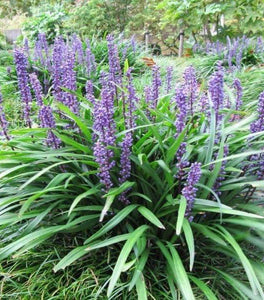
Images Depict Mature Plants
Variegated Liriope muscari Plants for Sale Online
Variegated Liriope (Liriope muscari 'Variegata')produces tufts of vibrant yellow striped foliage. Use Variegated Liriope with its arching, grass-like foliage to add color to any planting. Lilac flowers appear on stems as tall as the striped leaves.
The most recognizable feature of this perennial is its tufts of vibrant yellow and dark green leaves. Use Variegated Liriope to add color to any planting. Its grass-like foliage can grow 12 to 18 inches tall and wide.
In mid-summer, purple flowers appear on stems as tall as the leaves. After the flowers fade the stems are then covered with small blackberries. Liriope plants prefer well-drained, acidic soil and full sun for optimal growth.
This Liriope is perfect as an easy to grow, clump-forming ground cover. It is also great around perennial or shrub borders, in woodland gardens among trees and shrubs, as well as planted along walkways and paths.
Variegated Liriope produces tufts of vibrant yellow striped foliage. Use Variegated Liriope with its arching, grass-like foliage to add color to any planting. Lilac flowers appear on stems as tall as the leaves. After the flowers fade the stems are then covered with small black berries. An easy to grow, clump-forming groundcover or edging plant that can be used around perennial or shrub borders, as well as planted along walkways and paths.

| Hardiness Zone: | 6-11 |
|---|---|
| Mature Height: | 12 to 14 Inches |
| Mature Width: | 12 to 16 Inches |
| Classification: | Perennial |
| Sunlight: | Full sun |
| Habit: | Upright, clump forming |
| Flower Color: | Blue flowers |
| Flowering Season: | Summer |
| Foliage: | Green |
| Soil Condition: | Prefers average to moist soil |
| Water Requirements: | Water well until established |
| Uses: | Extremely attractive when used as a focal point in the mixed border, mass planting |
How to Care for Variegated Liriope
Before you buy a Variegated Liriope Plant, make sure to read about these recommended care instructions to keep this plant healthy and flourishing.
How do I water Variegated Liriope?
After backfilling and lightly compacting the 50/50 mix of existing soil and compost give the Variegated Liriope a good deep watering. This is not to be rushed. A general rule of thumb is to count to 5 for every one gallon of pot size. Check the plant daily for the first week or so and then every other day thereafter. Water using the counting method for the first few weeks. as mentioned Variegated Liriope does not like to dry out when first planted so make sure to provide enough water.
How do I mulch Variegated Liriope?
We highly recommend that you mulch your Variegated Liriope with either a ground hardwood mulch or a ground cypress. These are higher quality and will provide better nutrition overall as they breakdown. Mulching helps to keep weeds away which will compete with your new investment for water and nutrients. A 2 to 3-inch layer of mulch is sufficient, but not to cover any part of the stem of the plant with mulch. It's better to leave a one-inch gap of space between the mulch and the stem or base of the plant. One established Variegated Liriope will reduce your mulch cost and also labor year after year.
How do I fertilize Variegated Liriope?
Feeding your plants is probably the single most forgotten part of growing healthy long-lasting plants. Our ideal fertilizer schedule for you to use is as follows. Apply an early spring fertilizer to give the plant a boost of nitrogen potash that will be needed for healthy foliage and stem growth. We recommend a product such as Espoma Plant-tone. Espoma products are easy to use, just sprinkle around the base of the plant and water it in. Be careful with products such as miracle-grow as these products can burn newly planted plants when not used at the recommended rates. Slow-release fertilizer can help prevent rapid soft growth that is vulnerable to diseases and insects.
How do I plant a Variegated Liriope Plant?
When planting your newly purchased Variegated Liriope plants, we suggest that you dig a hole twice as wide as the root system but not deeper. The most common cause of plant death after transplanting is planting the new plant to deep. Depending on the quality of your existing soil you may need to add a locally sourced compost or topsoil to the back-fill soil. We do not recommend using topsoil by itself as back-fill because it will retain too much moisture and cause the root system to rot. Adding compost or topsoil will help the young feeder roots spread through the loose, nutrient-rich soil.

















